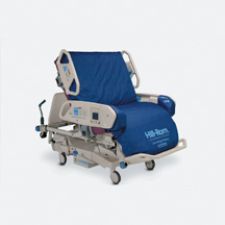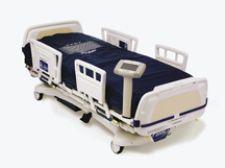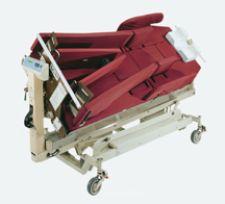
The TotalCare bed from Hill-Rom gives caregivers unrestrained access to higher acuity patients and their needs.
The changing demographic of patient care within this nation’s hospitals and healthcare systems is driving a need for better treatment technologies within every arena of care. More routine patient care is being serviced in outpatient clinics, outpatient surgical centers and similar venues. That said, many patients that are being treated within the hospital setting are critical care patients and/or patients with many more complex treatment issues than ever before.
Hospital treatment complexity is also being driven by several other factors, such as the aging populace in America, as well as the major improvements in medical treatments and technologies which contribute to a longer life expectancy. Patients who live longer tend to have greater healthcare needs. Additionally, the nation is facing an ever increasing number of nursing staff shortages across the continuum of healthcare delivery.
These factors and a host of similar ones are fueling a surge of interest in technological solutions that lessen the need for nurse intervention and the number of people who have to be involved in the individual nuances of patient care. Given these demographic realities, it is no wonder that today’s critical care beds have emerged as sophisticated high-tech wonders compared to the critical care beds of 10 or 15 years ago.
Standard features and optional and/or accessory features on today’s critical care beds are designed to make caregiver treatment access easy and safe. Patient positioning options are robust and refined, as well as simplistic to use by both the healthcare provider and the visiting family member. Manufacturers have put together an impressive array of features that make even the most immobile patient much easier to reposition and control.
Egress simplification functionality is a big plus in today’s critical care beds. Heightened egress options allow patients to return to full mobility much quicker than traditional beds allow. Egress capabilities also provide safer conditions for patients and allow nursing staffs more options for dealing with these historically difficult maneuvers without risking injury themselves. Side and end exit options that “help” with getting into a sitting position are just a few of the many egress enhancements that typify critical care beds.
Manufacturers are also addressing many of the other critical care patient concerns of recent years such as the effects of Ventilator Associated Pneumonia (VAP). Related preventative features include bed-embedded monitoring of head degree angle and associated time in varying positions and angles for long periods of patient bed use. Many of these features can be alarm activated as well to alert caregivers to potential risk associated with VAP prevention guidelines and protocols.
Patient weighing issues are being addressed with today’s critical care beds as well. Accurate patient weights can now be delivered at the touch of a button. This functionality can be a great timesaver for nursing staff, as well as providing extra insurance against the possibility of giving inadequate care based on an inappropriate weight measurement.
Critical care bed maneuverability has also improved substantially over the last few years. Technological improvements have been driven into the movement mechanics of these beds as well. The pushing force required to move patients from room to room, or procedure area to procedure area, is significantly reduced in today’s manufacturing lineup. Likewise, this extra mobility has been translated into easy to use functionality in this regard. Manufacturers are insuring that maneuverability is one of the strongest functions of these beds.
Ease-of-use issues are being addressed within most of the critical use functional components of the new line of critical care beds available in the marketplace. Although there are definitely distinctive traits amongst the critical care bed manufacturers, it is also true that ease of use is becoming less and less of a problem for discerning which purchase decision to make.
Technological improvements exist in a wide variety of other important functional aspects too. Radiological needs are addressed within the design of today’s critical care beds as well. Manufacturers are including a number of key features that make X-ray procedures easier to accomplish with critical care bed users. Likewise, bed extender options and retractable position options are prevalent within manufactured features.
The following features and functionality are also common to today’s critical care bed technological options:
• Motorized Driving Systems
• Communication Functions
• Extensive Mattress Options
• Bed Extenders/Retractors
• X-ray Cassette/Oxygen/IV Poles
• Improved Caster Mobility/Use
• Transducer Mounts/Traction Sleeve Kits
• Defibrillator/CPR Functionality
• Sophisticated Braking/Steering Capabilities
• Radiolucent/Fluoroscopic Aspects
• Litter Positioning/Patient Movement Assist
Without a doubt, the technological sophistication of today’s critical care beds are light-years ahead of where the manufacturing community was a decade ago. Versatility and ease of use have become commonplace features within this hospital bed market. Patient sensitive functionality has been driven into the manufacturing of these products as well. The marketplace today is primed correctly for meeting the changing needs of the busy nursing staffs and the complex critical care patient environment.




